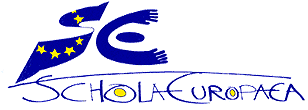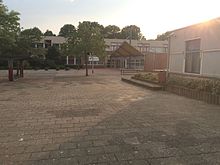European School Bergen
| European School Bergen | |
|---|---|

|
|
| type of school | comprehensive school |
| founding | 1963 |
| address |
Molenweidtje 5 |
| place | Bergen, NH |
| province | North Holland |
| Country | Netherlands |
| Coordinates | 52 ° 40 ′ 41 " N , 4 ° 42 ′ 23" E |
| carrier | EU Council of Ministers ( Supreme Council of the European Schools ), administered by the EU Commission |
| student | about 550 (July 8, 2016) |
| Teachers | 100 (July 8, 2016) |
| management | Steve Lewis |
| Website | esbergen.eu |
The European School Bergen (also Europese School Bergen, ESB or Schola Europaea Bergensis) is one of the 13 European Schools . It is located in the Netherlands in the North Holland city of Bergen .
history
Emergence
Like all European Schools, the Bergen European School was established close to a European institution or research establishment. One of the joint research centers of the European Commission, the Institute for Energy, is located in Petten, just a few kilometers away .
In 1963, the European School was founded in Bergen to ensure a suitable school education for the children of the researchers employed there. The school was initially set up for the children of the researchers and the teachers employed there. The offer was soon expanded. International companies based in the area have signed contracts with the school so that their employees' children can attend school. The school was also opened to private individuals, who, unlike the other students, pay a school fee. The amount depends on the number of children attending school and their age.
Recent developments
safety
In the early 2000s, the school was completely fenced. The fence itself was designed by a local artist and has not only functional but also decorative elements.
Since September 11th, increased security measures have been introduced in all European Schools by order of the competent authorities. These include the personal control of all persons entering the premises. As a result, non-members of the school are no longer allowed to enter the premises without prior notification. This also applies to graduates of the school itself and former staff. Visitors to the school must visibly wear a visitor ID at all times and present it on request. You will receive this from the security at the entrance after registration by the school management.
Persistence
After the number of students decreased significantly in the early years of the last decade, which led to the closure of two language sections (It / DE), the numbers are now constant at a lower level (~ 600). As a result, the continued existence of the school can be seen as secure today.
education
Curriculum
The teaching content corresponds to that of all European Schools, as determined by the responsible authorities in consultation with all education ministries of the participating countries. The school is divided into a crèche for children from two years of age, a kindergarten for children from the age of four, a five-class primary school (P1 - P5) and a seven-class secondary school S1 - S7. The school is strictly bilingual, from the third secondary class (S3) the social science subjects must be taken in the first foreign language (English, German or French). In grade S2, pupils have to choose another (European) foreign language and from S3 onwards, Latin is offered in the reference languages French, English or Dutch. In S4 they can take another foreign language or business studies or continue Latin.
Bedingung für die Einrichtung der Kurse ist eine Mindestanzahl von 7 Schülerinnen und Schülern in den Klassenstufen S1- S5 sowie 5 Schülerinnen und Schüler in der S6 und S7. Ausgenommen von dieser Regelung sind die verpflichtenden Kurse in der Muttersprache, der ersten Fremdsprache, Mathematik und den Grundkursen in Geographie und Geschichte. Es ist bei der Stundenplangestaltung möglich, dass diese Kurse jahrgangsübergreifend oder sprachsektionsübergreifend organisiert werden, sofern dies sinnvoll ist.
From the S6 onwards, the school offers Dutch in a preparatory course for the Dutch language diploma NT2, which is a prerequisite for studying in the Netherlands. The school leads to the European Abitur . Other degrees are not explicitly offered; this also applies to degrees that exist in Germany, such as B. the secondary qualification I. Recognition of a secondary school qualification (according to S5) or the advanced technical college entrance qualification in Germany (according to S6) is theoretically possible through a formal application to the state school authorities. The condition for admission to the European school leaving examination is the continuous attendance of grades S6 and S7 with the same subject canon, which correspond to the German grades 11 and 12. The final exam consists of five written parts in the subjects of mathematics, first language (mother tongue) and second language, which is taught from the first grade of primary school. Furthermore, the students have to take a written exam in two further advanced courses in the field of social or natural sciences or art / music or philosophy. These are supplemented by three oral exams in at least the first and second language and one additional subject that was not the subject of the written examination.
A special feature of all European schools is the possibility of receiving mother-tongue lessons for all languages of the European Union. This is partly through "face to face" lessons, e.g. T. made possible with the help of video conferencing. A feature of this European School is also the possibility of supplementing the regular math lessons at basic course level (3 school hours per week) or advanced course level (5 school hours per week) with an intensive math course with a further 3 school hours per week. This offer can also be carried out in cooperation with other European schools in a "distance learning" program for pupils of all language sections in the final classes if the minimum number of 5 courses in a school is not reached. Advanced courses with an additional offer of 3 hours per week are also possible in the area of the mother tongue and the first foreign language.
Language sections
As at the other European Schools, the pupils at the Bergen European School are divided into different language sections. As a rule, the student's mother tongue is decisive. As a rule there is at least one German, one English and one French section, and in countries in which none of the three languages is an official language a section in the official language of the host country, here Dutch.
There are currently three language sections at the European School Bergen: English, French and Dutch.
The school was founded with five sections, but the German and Italian language sections were discontinued in recent years due to insufficient student numbers.
Division into language sections
Exceptions are made to this rule. This is especially true for all the students for whose mother tongue there is no language section. These can then either go to the English or French section. This procedure is common in all smaller European Schools, but it is not without controversy. The English section in particular suffers from a lack of language skills, the non-native speakers, which partially affects the quality of the teaching. This problem is alleviated by comprehensive auxiliary teaching and e.g. T. individual care but encountered.
facts and figures
Student numbers
On October 12, 2003, 696 students attended the European School in Bergen. 68 of these were in kindergarten, 249 in elementary school and 379 in secondary school.
Parents Association
As in all European Schools, the Parents' Association (PA) also plays a central role in the European School. This applies above all to the organization of transport to and from the school, for students from outside. Most of the students commute from Amsterdam , Amstelveen or Den Helder . School buses are organized for these by the PA.
In addition, at the end of each school year, the PA organizes book markets for the resale of textbooks that are no longer required, as well as taking bulk orders for schoolbooks from all countries.
Cooperation with other European schools
The school is actively involved in joint activities between the European Schools. This includes the European Schools Science Symposium and Eurosport . Regular successes at the European Schools Science Symposium also resulted in the participation of pupils from the European School in Bergen, as representatives of all European Schools at EUCYS .
Web links
Individual evidence
- ^ A b Digital Brochure for the European School Bergen, “Europe in a School”. (PDF) European School Bergen, July 8, 2016, accessed on October 23, 2016 .
